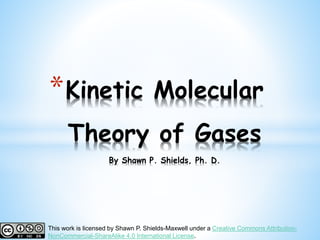
Unit 10 kinetic theory fl14 final
- 1. *Kinetic Molecular Theory of Gases By Shawn P. Shields, Ph. D. This work is licensed by Shawn P. Shields-Maxwell under a Creative Commons Attribution- NonCommercial-ShareAlike 4.0 International License.
- 2. *The Microscopic Basis for Gas Pressure… *Gas molecules are in constant random motion in a container. *Molecules create “pressure” through collisions with the walls of the container. *Pressure is a force per unit area 𝐏 = 𝐅𝐨𝐫𝐜𝐞 𝐀𝐫𝐞𝐚
- 3. *The Microscopic Basis for Gas Pressure… *Suppose we decrease the volume of the container, but keep the temperature and moles of gas constant. *What happens to the pressure? *It increases… (more collisions per unit area) Pressure is related to molecular motion.
- 4. *The Microscopic Basis for Temperature… *What about temperature? *Recall kinetic energy K.E. = ½ mv2 Kinetic molecular theory says that the average velocity of gas molecules increases with increasing temperature. Temperature , Avg velocity
- 5. *The Microscopic Basis for Temperature… *Since the average velocity of gas molecules increases with increasing temperature, the number of collisions with the walls of the container increases, as well. Temperature Avg velocity # collisions
- 6. *The Microscopic Basis for Temperature… *More energy, through momentum, is transferred to the walls of the container. *Temperature is a measure of the average kinetic energy of the gas molecules. Temperature , Avg velocity , # collisions Energy transferred to the walls of the container increases!
- 7. *The Kinetic Theory of Gases The Kinetic Theory of Gases derives relationships between the macroscopic properties of gases (pressure, volume, and temperature) and the microscopic behavior of the molecules in the gas. It provides a microscopic definition of temperature as a measure of the average kinetic energy of the molecules in a gas.
- 8. *Assumptions in the Kinetic Theory of Gases • The gas is ideal. (The molecules do not interact with each other.) • Collisions of the molecules with the walls of the vessel are elastic (i.e., no energy is lost in the collision). • Gas molecules move constantly in random directions with a distribution of speeds. Overall, they have an average velocity. • The average kinetic energy of the gas particles is proportional to temperature.
- 9. *Other Info Regarding the Kinetic Theory of Gases The kinetic theory of gases only involves kinetic energy…no potential energy. (This is why the collisions are ‘elastic.’) This will change when we talk about real gases, as opposed to ideal gases! Molecules at the same temperature have the same average kinetic energy, regardless of their identity. However, remember that kinetic energy is related to both mass and velocity.
- 10. *The Average Kinetic Energy of Gas Molecules According to the Kinetic Theory of Gases, the average kinetic energy per mole of gas molecules can be calculated 𝐊𝐄 = 𝟑 𝟐 𝐑𝐓 Notice that the average kinetic energy (in J) of a sample of gas molecules only depends on the temperature (in K)! The gas constant R is the “Energy R”: 𝐑 = 𝟖. 𝟑𝟏𝟒 𝐉 𝐦𝐨𝐥 𝐊 1 J = 1 𝐤𝐠 𝐦 𝟐 𝐬 𝟐 The “Joule” is an energy unit (J).
- 11. *The Average Velocity of Gas Molecules The rms speed (𝑣𝑟𝑚𝑠) or type of average speed of the gas molecules can also be calculated 𝒗 𝒓𝒎𝒔 = 𝟑𝑹𝑻 𝑴 Where M is the molar mass of the gas (in kg) T is the temperature (in K) R is the gas constant in J! 𝐑 = 𝟖. 𝟑𝟏𝟒 𝐉 𝐦𝐨𝐥 𝐊 The “Energy R”
- 12. *Comparing the Average Velocity of Gas Molecules Suppose we have a sample of O2 and H2 gas molecules in the same flask at the same temperature (298K). Which type of gas molecules have a higher average velocity (vrms)?
- 13. *Comparing the Average Velocity of Gas Molecules Suppose we have a sample of O2 and H2 gas molecules in the same flask at the same temperature (298 K). Which type of gas molecules have a higher average velocity? Ask yourself: Does O2 or H2 have greater molar mass (M)? If the T is constant (and thus the avg KE is the same for both gases), how would vrms relate to M? KE = ½mv2
- 14. *Comparing the Average Velocity of Gas Molecules Suppose we have a sample of O2 and H2 gas molecules in the same flask at the same temperature. Which type of gas molecules have a higher average velocity? Does O2 or H2 have greater molar mass (M)? O2 has a larger M How does vrms relate to kinetic energy (and thus the temperature?) KE = ½mv2 The molar mass of the gas molecules is inversely related to the avg velocity, if KE is held constant.
- 15. *Comparing the Average Velocity of Gas Molecules Suppose we have a sample of O2 and H2 gas molecules in the same flask at the same temperature. Which type of gas molecules have a higher average velocity? KE = ½mv2 If M increases , then vrms decreases The H2 molecules would have higher avg velocity, since they have a smaller molar mass (M).
- 16. *Comparing the Average Velocity of Gas Molecules Suppose we have a sample of O2 and H2 gas molecules in the same flask at the same temperature. Which type of gas molecules have a higher average velocity? We could also rationalize this using 𝒗 𝒓𝒎𝒔 = 𝟑𝑹𝑻 𝑴 If M increases , then vrms decreases We get the same answer.
